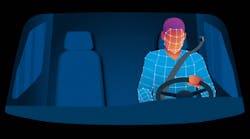Even seemingly minor distractions can have a devastating impact on the safety of drivers and the motoring public. The consequences of using smartphones to text or talk, eating food behind the wheel or fatigue to the point of microsleeping can all lead to accidents when a driver is operating a commercial vehicle.
Mitigating distracted driving through safety programs and real-time driver monitoring can aid in improving driver safety, reduce risk of damage to equipment and property, prevent injury or death, and can help control the cost of insurance premiums.
A recent webinar titled "Proactively spotting distracted driving with advanced technology" shared research on distracted driving and input from fleets who utilize video monitoring technology to observe driver behavior and improve safety.
The virtual event was hosted by FleetOwner and sponsored by Lytx, a provider of video telematics and safety systems.
Dr. Jeffrey Hickman, group leader for the Virginia Tech Transportation Institute, shared insights on the organization’s extensive research into distracted driving.
The first step is recognizing the difference between highly practiced tasks. Hickman offered the example of chewing gum and walking at the same time. Multitasking can be done with these highly practiced tasks. However, when a driver is presented with two demanding cognitive tasks, this is where distracted driving can occur.
“What's happening here is you're really switching your attention and you think you're multitasking, but it's happening so fast, but you're really switching back and forth,” advised Hickman. “Whenever you have to take your eyes off the road, that is where we see risk.”
Root cause and proactive measures
Kansas City-Mo.-based American Central Transport (ACT) has utilized in-cab safety technology since 2014, which has helped with risk management, particularly when it comes to finding and correcting distracted driving behavior.
“It’s been a great tool to coach our drivers and to recognize safety, and exonerate drivers when they were not in the wrong,” said Brandon Leininger, director of risk management for American Central Transport.
“We have used that technology to continuously improve our fleet and our drivers. We feel that it's a great tool to help coach them up,” Leininger added. “We've also been able to identify positive recognition as well in our program for when drivers are doing what is asked of them and doing everything they can to stay safe and prevent accidents and incidents on the roadway.”
ACT uses the Lytx safety monitoring technology, with inward- and outward-facing cameras with recording capabilities, to monitor driver behavior and safety. When an event is triggered, the system captures 20 seconds of inward-facing and outward-facing footage. The system utilizes specific algorithms to assess and alert the fleet on distracted driving events, to help separate false positives from actual events that require correction.
Bob Verret, the chief information officer for Dupre Logistics, said his fleet recognizes both distracted driving caused by an outside influence and through condition-based challenges such as fatigue or impairment.
Verret’s approach to mitigate distracted driving events has been to adhere to the following steps: plan, identify, execute, coach, measure, and improve.
Prior to using a camera safety technology, Verret advised the fleet would utilize electronic logging device (ELD) data, which unveiled that drivers struggled to adjust to different driving shifts.
“When we were switching drivers from night shift to day shift or vice versa, we really disrupted their circadian rhythms,” said Verret.
The challenge Dupre Logistics faced was the one-month lag-time in receiving that data from ELDs, which caused delays in correcting driver behaviors.
“The faster you can get to talking to coaching the driver about a bad behavior, the faster you can fix it, and the more effective that becomes,” said Verret.
Having video evidence can provide an unbiased perspective on what actually occurred at the time of the event. Follow-up is critical to ensure that drivers understand and correct behaviors.
“We still believe the coaching activity makes the difference,” said Verret. “You can see these events, the driver knows they're happening. They just kind of shrug them off, but when you coach them and you sit them down and show them what actually happened on the roadway from the camera's perspective, it's amazing, the impact that it'll have, and the change in behavior that you get in terms of safe driving.”
He emphasized the importance of using a compassionate and fact-based approach when coaching drivers. It is also critical to assess and measure coaching effectiveness.
“When we have a different terminal managers that maybe aren't the best at coaching, we can see that their coaching is not having an impact on improving different campaigns we might be running at that point in time,” Verret said. “It gives us an opportunity to improve the coaching, but also gives us an opportunity for recognition for those that do a very good job.”
Utilizing the latest technology
Lytx shared insights on different processes and products available to spot distracted driving, with tips to provide corrective action before an accident might occur.
Both ACT and Dupre Logistics utilize the latest Lytx products with collision mitigation technology, that will provide real-time feedback to drivers through audible alerts. Additionally, the fleets utilize facial recognition software, known as machine vision with artificial intelligence, or MV + AI, technology to read and detect movements and determine if a driver is distracted.
“When you think of a driver on the road, the machine vision will see an object like a cell phone, and then it will detect the driver's head moving,” explained Lisa Gonzalez, senior product manager at Lytx. “Then artificial intelligence uses logic to determine that this combination is risky.”
“Imagine the driver picking up the phone,” continued Gonzalez. “The machine vision detecting the cell phone can also deliver an alert, basically telling the driver 'hey stop,' and ideally that driver would put the phone down.”
The use of this real-time feedback allows drivers to correct behaviors earlier.
“If the driver is following too close, let's say, they're going to get the immediate feedback,” said Leininger. “We don't have to wait for a hard braking application to occur and then give us the event to then coach the driver a day later.”
“The new AI detection will find head bobs and eye movements, and if the driver’s not wearing sunglasses, they'll get an audible alert (in the cab),” advised Verret. “We’ve coached them to pull over, get a cup of coffee, take a rest, call your dispatcher, make sure everything's OK.”
Utilizing multiple forms of monitoring devices allows for a more comprehensive view to determine the root cause of an event.
“We might see a swerve, but you realize the swerve was because the driver took his eyes off the road momentarily to grab something from a seat, or something of that nature,” said Verret. “It starts to put it all together, so you get a much better understanding.”
Due to the technology made available through Lytx, Leininger advised the fleet has been able to find other root causes of distracted driving, such as eating and drinking.
“Anything that takes the eyes off the road and hands off the steering wheel obviously is something that you want to be aware of and coach with the driver appropriately,” Leninger advised.
He offered up more details on how the Lytx safety products have assisted with catching another root cause of distracted driving: prolonged viewing of a smartphone screen.
“We've seen events where a few drivers had their phones mounted, like they're supposed to, and they're not holding it, or even touching the screen for that matter, but you watch the footage and you realize that their eyes are looking down periodically because they're streaming some kind of chat or video,” he said.




